F
|
|
| Fistulina hepatica (Beefsteak Fungus) |

|
Aug 22, 2025. In Tinkers Wood John Catterson spotted this bracket on an Oak log a few days ago and returned to check it today, now complete with a realistic 'drop of blood'! Often an early fruiter, it is probably commonest on Oak though usually on standing trunks rather than logs, but also occurs on Sweet Chestnut and occasionally on Beech.
|
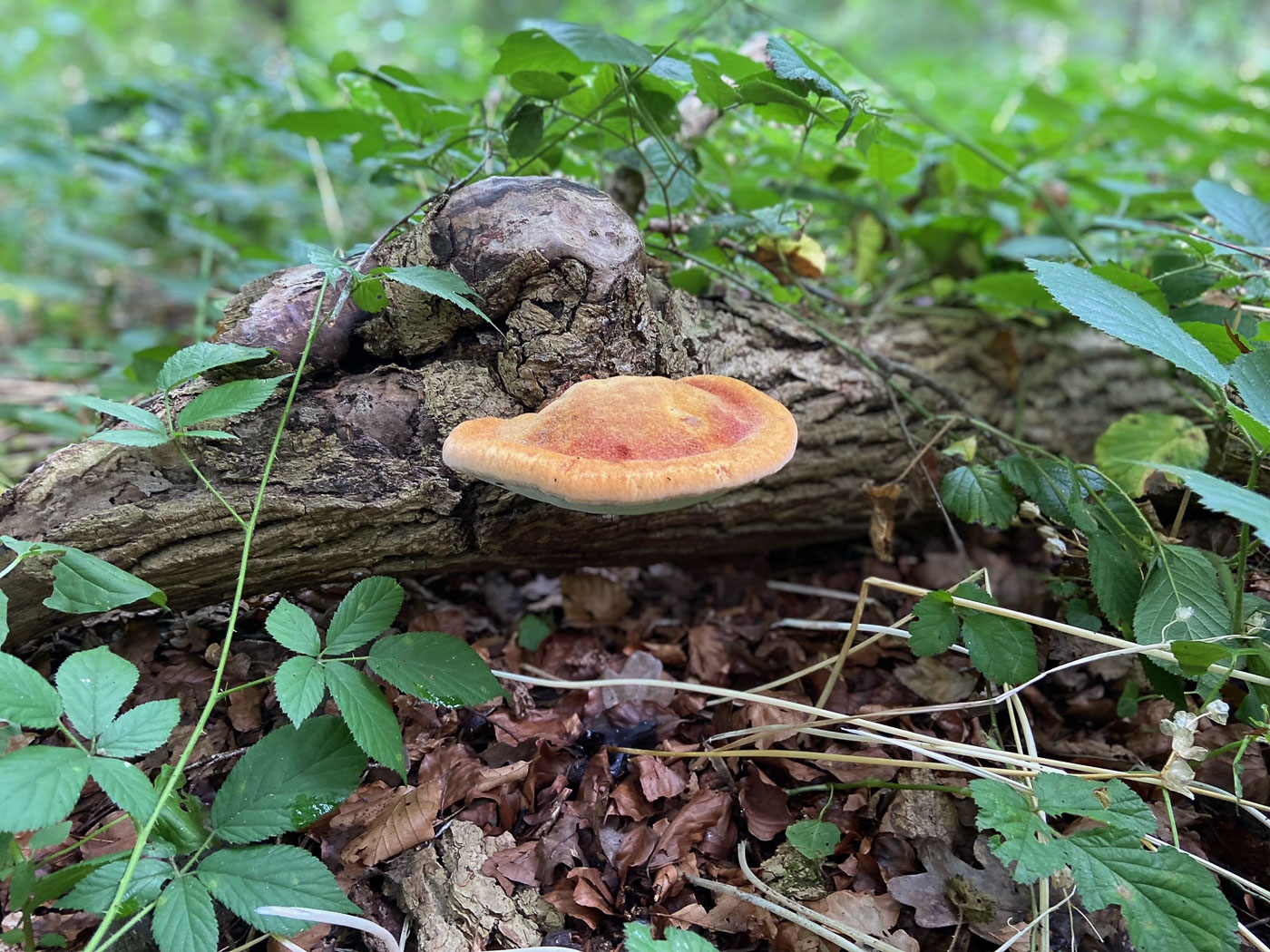
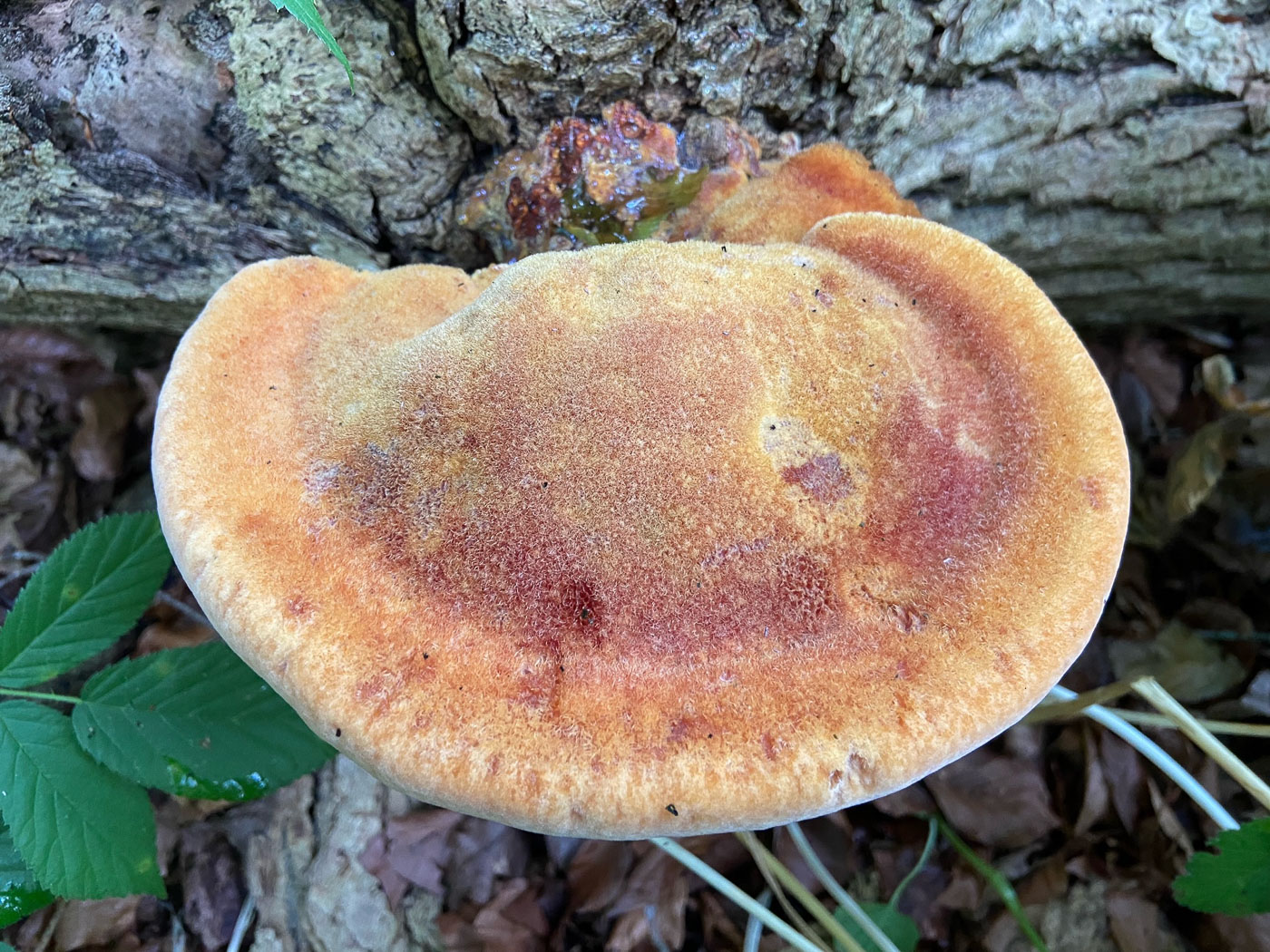
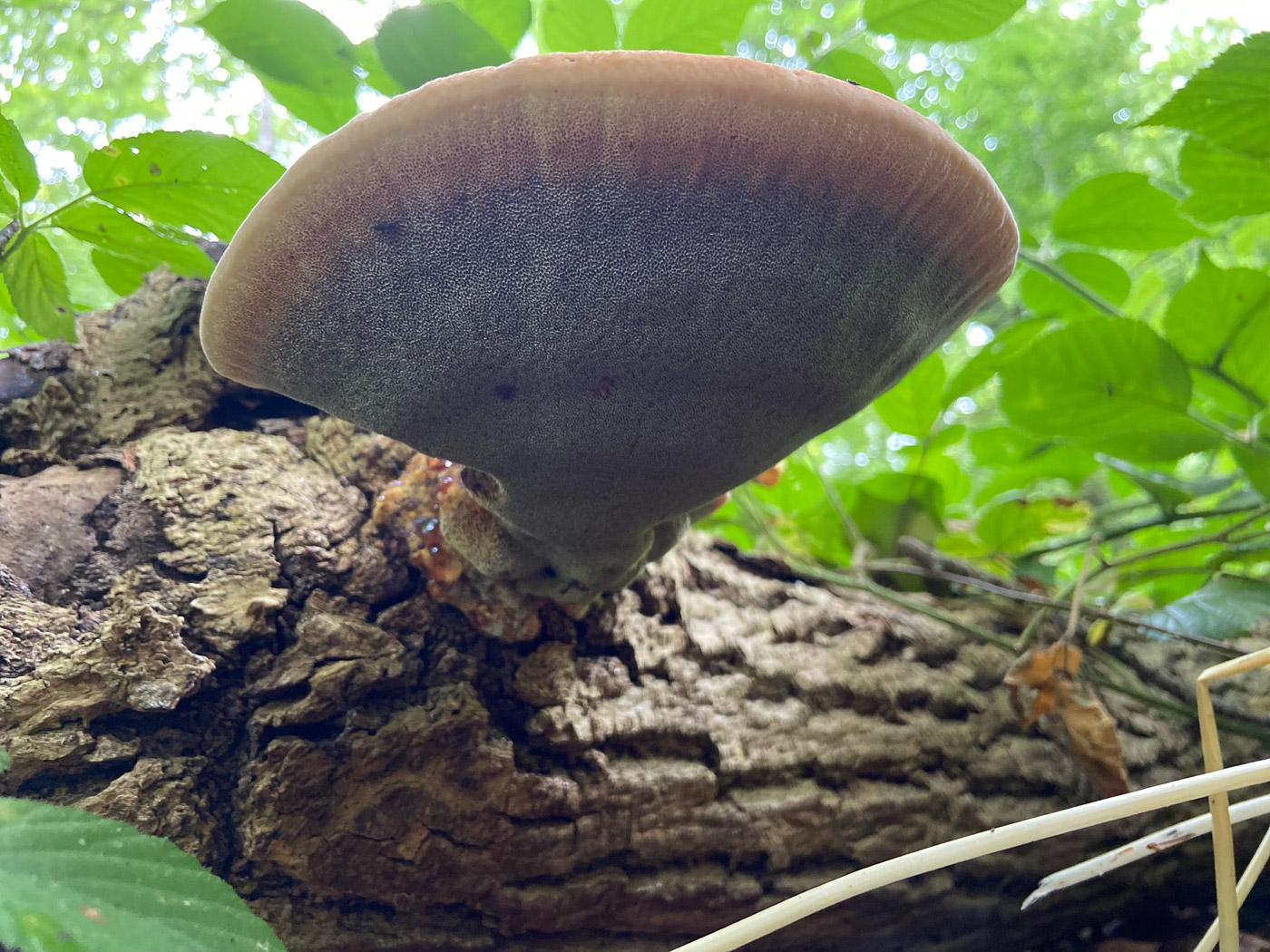
 |
Aug 15, 2024. In Pullingshill Wood Stephen Plummer found this attractive bracket on fallen Oak and sent his photos (1-3) to Penny for confirmation as this was young material and not yet showing the exterior blood red signs which give the species away. Photo 4 was sent in by Gill Ferguson from Burnham Beeches two days later with no doubt about the typical bloody signs here! This is about the time to be looking out for this charismatic bracket which is soft in texture and often to be found on standing or fallen Oak. |


 |
Sep 23, 2023 Fistulina hepatica but in its anamorph state. In Bernwood Forest Chris Grimbly noticed this somewhat strangely malformed dripping red lump on a living Oak trunk and realised it was likely to be some form of Beefsteak. Some research online uncovered the rare anamorphic stage of this species originally called Confistulina hepatica. An anamorph is the asexual state of a fungus (not unusual amongst Ascomycetes but rarer in Basidiomycetes). Often anamorphs had different names unconnected to their 'normal' counterparts because they appeared to be a different species, but with the advance of science and the realisation of the link between a species in its asexual and 'normal' fertile state the separate names are now abandoned. Note how the example here has not formed a bracket shape and is lacking the flat pale poroid underside which develops normally in F. hepatica though its red colour and telltale bloodlike droplets provide an obvious connection. We have no record of this form of the species having been found in the county.
|

 |
Sep 13, 2022. On a large Oak in Burnham Beeches Penny spotted a tiny bright red patch from a distance, and on closer inspection found it was as she suspected: the beginning stage of this species, only an inch or so across. Further round the same trunk she found a somewhat malformed larger example which was oozing the typical 'bloody' liquid after which the species is named. |
 |
Aug 27, 2022. In Tinkers Wood John Catterson noticed this young bracket in a fissure in an Oak trunk. This species is often an early season fruiter and favours Oak as well, so one to look out for now even in these drought conditions. |

 |
Sep 12, 2020. This unusually double-headed specimen was found on a Beech log in Naphill Common by Paul Goby. Often fruiting at this time, the species is more commonly found on living Oak. The two views seen here were taken from directly above and directly below the specimen, the fine pores visible on the underside being the fertile surface from which the spores drop. |
 |
Oct 11, 2020. This magnificent specimen was growing on Oak roots at Pullingshill Wood, found by Penny Cullington. Though we already have good photos of the species (dated Sept 12th), the recent rain had made today's example almost as macabre as it gets and it certainly deserves a place in our list in its own right! It was about 1 ft across and if you hadn't known such a fungal species existed you'd probably have thought some poor creature had come to a very sticky end! No explanation is needed as to why it was given its apt common name. |
| Flammula (previously Pholiota) alnicola (Alder Scalycap) |

 |
Aug 5, 2023.  In mixed woodland at Burnham Beeches Russell Ness found this strikingly bright yellow singleton on an unidentified stick, the rusty brown spore print and micro-features of which led him to this ID. Previously in genus Pholiota, the species most frequently occurs clustered at the base of Birch (despite its misleading common name) - the stick looks like Birch here - but can also be found with other deciduous trees. Note the faint ring zone on the stem and orange flecks below this and on the cap both at the margin and the centre. This is a first for Finds and we have very few county records this century. In mixed woodland at Burnham Beeches Russell Ness found this strikingly bright yellow singleton on an unidentified stick, the rusty brown spore print and micro-features of which led him to this ID. Previously in genus Pholiota, the species most frequently occurs clustered at the base of Birch (despite its misleading common name) - the stick looks like Birch here - but can also be found with other deciduous trees. Note the faint ring zone on the stem and orange flecks below this and on the cap both at the margin and the centre. This is a first for Finds and we have very few county records this century.
|
| Flammulaster carpophilus (Leaf Spark) |

 |
Nov 16, 2021. On a Beech cupule in Piggots Wood Claire Williams noticed this tiny Mycenoid species and suspected it was something she'd not met before. It is in fact an unusual species Penny had been on the lookout for in Beech litter but had failed to find this year. The pale rusty gill colour tells one that it's not a Mycena (Bonnet), and it resembles a very small Tubaria (Twiglet) but has a long thin stem with a relatively small rounded granular cap. Though its common name implies it frequenting leaves, Penny has only found it on Beech cupules in this area which it seems to favour but it is never common and is easily overlooked.
|
| Flammulina velutipes (Velvet Shank) |

 |
Jan 3, 2024. On a moss covered broadleaf stump in Salden Wood Bob Simpson found this typically winter species. It favours deciduous wood, often tightly clustered on living trunks and flourishes in both frosty and snowy conditions. Caps are brightly coloured but the give-away feature is the dark lower stem which is finely furry. One to look out for at this time of year. |

 |
Mar 19, 2023. At Turville Heath Penny was suitably surprised to find that the mild damp recent spell had stirred quite a few species into action, the first being this sizeable clump which she nearly missed - peering around for much smaller fry amongst the woody litter under a large Pine. This is a Winter fruiter, often on wood but here was around the trunk base looking not unlike a tight clump of Gymnopus fusipes (Spindle Toughshank)! It is commonly found on a wide range of deciduous trees and shrubs, also on Gorse, but it seems is very rarely recorded with conifer as here. |

 |
Feb 23, 2023. In Salden Wood (owned by Bob Simpson) Bob found this winter fruiting species on various hardwood stumps. We have a previous entry this year on January 2nd (though just into Berkshire!) and it's always nice to see any fresh mushroom at this time, especially one which grows in impressive clusters as this often does, whatever the weather. |

 |
Jan 2, 2023. Penny is breaking the county rule here because her husband Paul found and photoed this impressive display just over the border into Berkshire! The species is common in winter, often found in frosty and snowy conditions fruiting on a wide variety of deciduous trees, so is definitely one to look out for as conditions are clearly favourable just now. Note the dark finely velvety stem which is a good field character. |

 |
Jan 3, 2022. In Brill Common on a deciduous log Joanna Dodsworth found this typical late season species - one that often doesn't make an appearance until after the first frosts and can even be found in really wintry weather. It forms tight clumps on fallen deciduous wood, both standing and fallen, and occasionally occurs on conifer. Photo 2 is a magnificent clump of the same species found by Jackie Ewan at Stampwell Farm on a standing Ash trunk the next day. |


 |
Jan 8, 2021. We already have one image of this common winter mushroom but of older rather dark specimens. Today's photos, taken by Claire Williams in Downley Common Wood, are of young and fresh though frozen material which is considerably paler than our previous image. The stem, often much darker and finely velvety towards the base than shown here, can start off much paler all over, but still visible here (if you can zoom in on photo 3) are the tiny hairs - some of them considerably darker than the general stem colour. |
 |
Jan 6, 2021. On Joanna Dodsworth's walk around Brill she found this impressive clump on a standing dead Willow trunk. This is a species often fruiting during winter and can often be found even in snowy conditions. The caps are often considerably paler and yellower than shown here but the features to note in the field are its tightly clustered habit on deciduous wood (often standing) and the finely hairy stem which becomes darker to black towards the base. Penny was surprised we had only one collection of this in Finds 2020 (dated Oct 26th), so it's clearly one to be looking out for now. |


 |
Oct 26, 2020. Penny C. found this large and very slimy cluster on a rotting Beech log in Mousells Wood. This is definitely a late season species, often fruiting well after the frosts start and even with snow on the ground. So yet another sign that we are moving into late autumn now. This collection was pretty soggy so the velvet stem coating - a diagnostic feature - is not as distinctive here but can be seen in photo 3 on the young cluster. Note also the stem colour: pale at the top but quickly much darker reddish to black towards the base. The caps here were less than 3 cms across but can get bigger than this. Do not confuse with similar clusters of Pholiota (Scalycap) which do not always have scaly caps! However, the gills of Pholiota will always turn brown from the brown spores, whereas the gills and spores of Flammulina are whitish to pale yellow at most. |
| Fomes fomentarius (Hoof Fungus) |

 |
Oct 1, 2023. In Burnham Beeches Jim Wills found this distinctive bracket growing on Birch. A few years ago this would have been a notable find in the county - our first records dating from 2019 - but it is now well established and spreading rapidly on both standing and fallen Birch. |


 |
Jan 16, 2022. In Hodgemoor Woods Jim Wills noticed this distinctive bracket on quite a few Birch trunks both standing and fallen, commenting that on one trunk there were 40 specimens! Photo 2 shows its pore surface underneath. Photo 3 was taken by Penny at Burnham Beeches the following day, also on fallen Birch where the species now appears to be almost as common as Fomitopsis betulina (Birch Bracket). Interestingly Jim also reports this fungus on Red Maple in Chalfont St. Peter. |
 |
Nov 30, 2020. We have this rare and interesting bracket already (dated Sept 15) - see notes under that species for more comments. Today's specimen on fallen Birch in the Mire in Burnham Beeches, found by Penny C., was notable because of the new small 'hooves' which were forming at right angles on the underside (the old pores) of a previous year's bracket. However, even when this small - not more than 3 cms across - the distinct 'hoof' shape is clear to see. |
 |
Sep 15, 2020. Penny Cullington found this aptly named and quite rare bracket growing on fallen Birch at Burnham Beeches. A few years ago this species was hardly known in the south though was quite common in Scotland and N. England - always on Birch. It now seems to be spreading rapidly south and is recorded from several sites in the county but is still considered a rarity. |
| Fomitopsis betulina (Birch Polypore) |
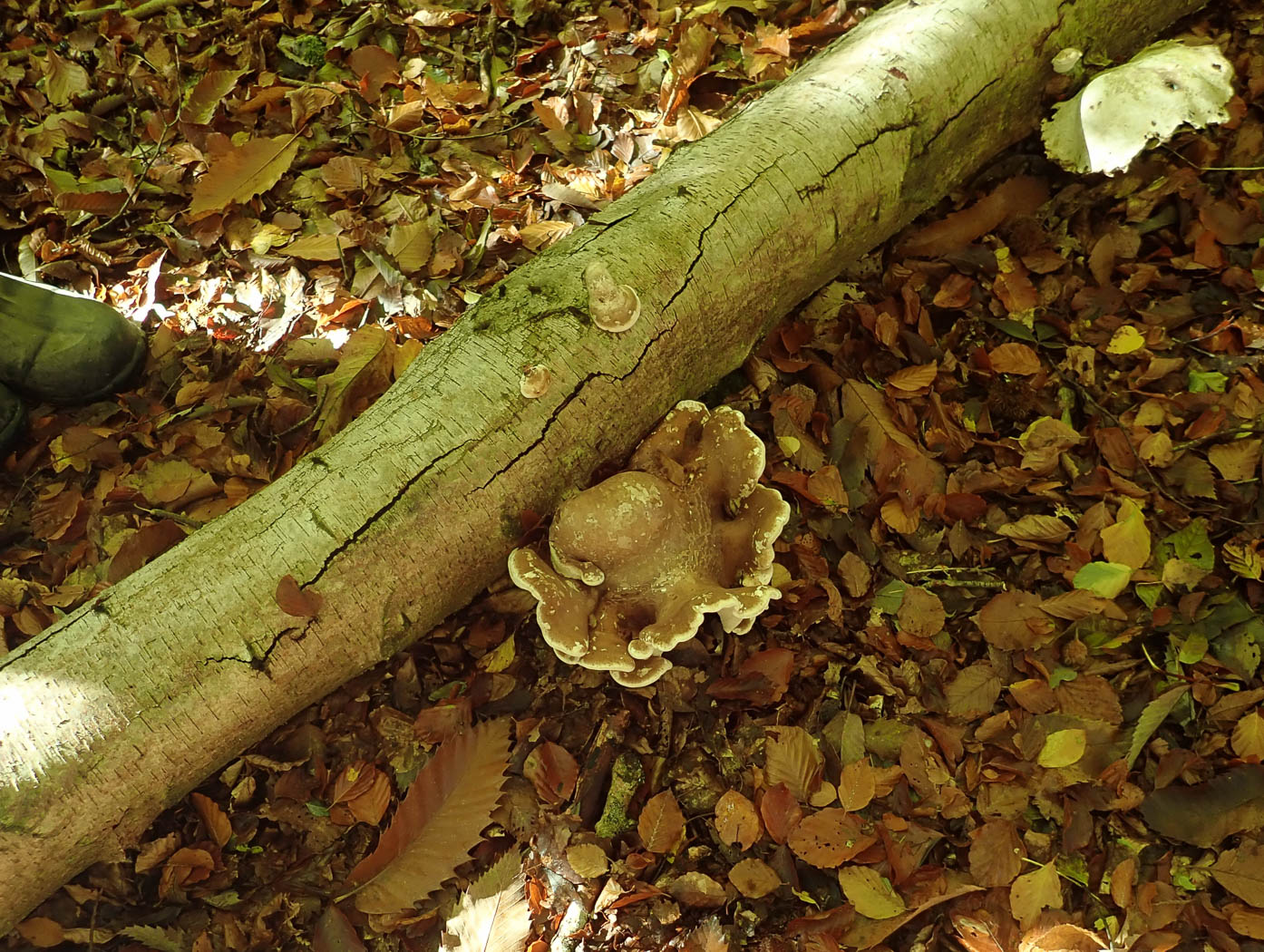
|
Oct 24, 2025. In Gussetts Wood Penny couldn't resist taking this photo of one of our commonest brackets because of its size - 20 cms across - and wonderfully erratic wavy edged shape. Just above it are two immature examples which show just how much its appearance can change as it develops. The species only occurs on fallen or dying Birch. |


 |
Jan 8, 2023. On fallen Birch at Burnham Beeches Penny saw many examples of this species - one of our commonest brackets though one which seems to get confused in the field with Ganoderma or (when just developing) even Lycoperdon (Puffball)! Previously in genus Piptoporus, its mature shape seen here (photo 1) is typical, also slightly spongy to the touch unlike the somewhat hard Ganoderma, also the very fine pores underneath (photo 2) remain pale when damaged / scratched unlike the instant brown staining of Ganoderma - the marking seen here are insect damage. Photo 3 shows another smaller bracket, also a much smaller white undeveloped 'button' - still the same species and not a Puffball! |



 |
Jan 17, 2022. In Burnham Beeches on fallen Birch Penny found some old fruitbodies of this common bracket (previously Piptoporus betulinus) and, knowing the likelihood of then finding this ascomycete growing on the pores, she broke a bracket off to take a look underneath. Sure enough there it was (previously Hypocrea pulvinata). Photos 2 and 3 show it at an early whitish stage, in photo 4 it is just beginning to turn yellow. It eventually turns ochre then brownish in age. It is only found on the underside of old fruitbodies. |

 |
Sep 29, 2022. This is a species which abounds on the many Birches at Stoke Common, found today by Penny. Previously, and more familiar, in genus Piptoporus, the brackets are easily recognisable when well developed as here, but often seem to catch people out when young, pure white and looking more like a puffball! |
 |
Sep 18, 2020. A very common bracket wherever there are Birches, with which it is host specific, this was found by Penny Cullington on a fallen Birch log in Hodgemoor Wood. Much more familiar by its older name of Piptoporus betulinus, it has tiny white pores underneath and grows on both fallen and living trunks and branches and is one of the easiest fungi to recognise. |
| Fomitopsis pinicola (Redbelted Bracket) |
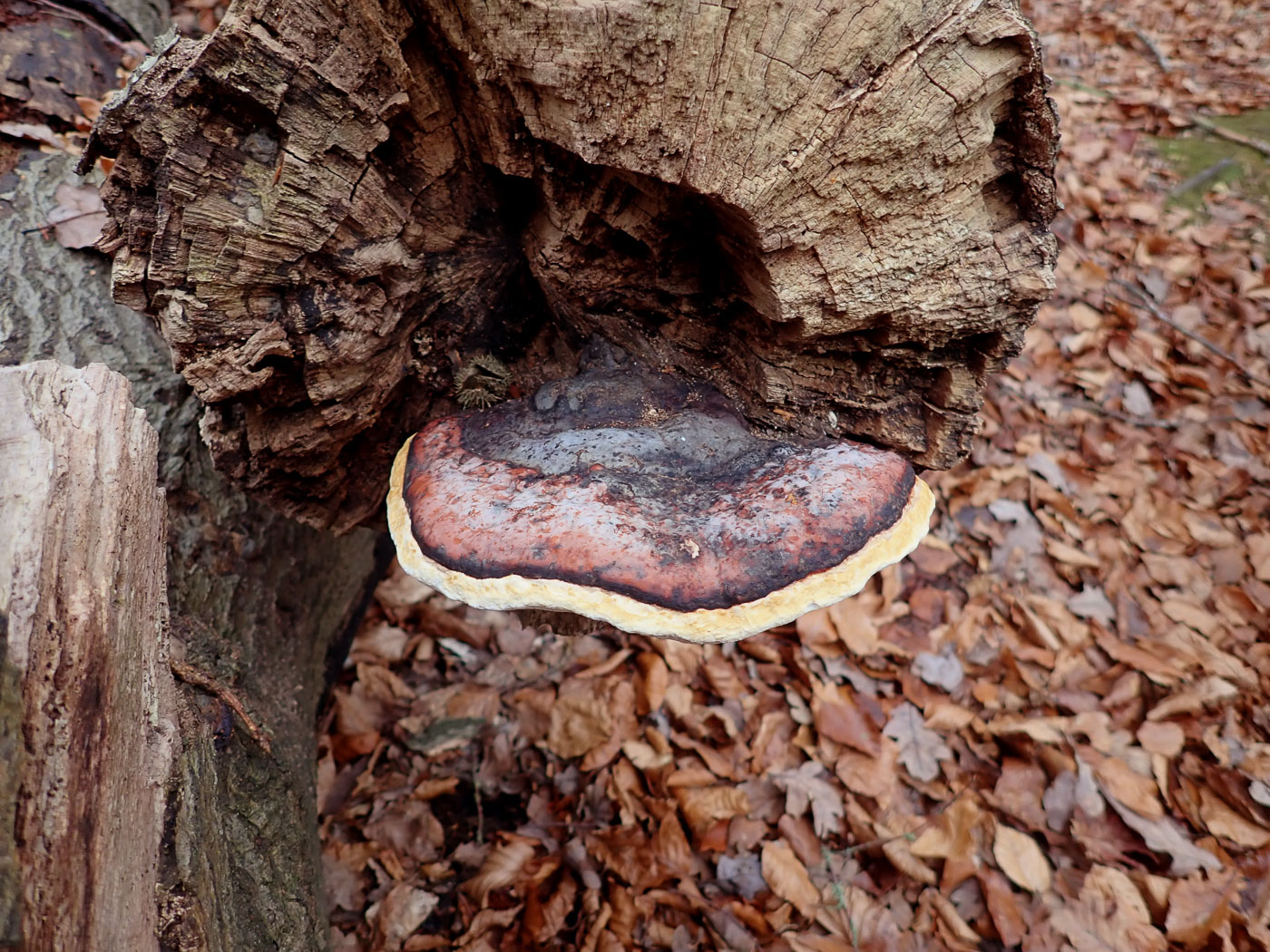
m.jpg) |
Dec 12, 2024. On a fallen Beech trunk at Burnham Beeches our small group admired this now common bracket which is a regular on this particular trunk. The mature singleton (Penny's photo) was impressively marked with the red belt though when younger this features is far less obvious making the species quite difficult to separate from other similar hard brackets. Photo 2 is of a less mature collection we found a week earlier here on fallen Birch, taken by Claudi Soler, when we also found it on standing Pine - the host for which it is named though it is by no means restricted to that tree and seems much more common on both Beech and Birch here. |
 |
Apr 16, 2024. In Gt. Beard's Wood nr Beaconsfield Sarah Ebdon came across this example of a bracket which is becoming increasingly common locally, this time found on Birch and really showing off its red outer belts to perfection. When looking as it is here it is an easy one to name, but glancing through our many other entries will show how very different in appearance it can be depending on its stage of maturity. It seems to be common on both Beech and Birch though is less frequent around here on Pine despite its Latin species name. |


 |
Jan 25, 2024. We have a growing number of examples of this interesting bracket which is becoming quite common, but despite its name all so far have been on Birch or Beech. Here, however, is an nice example found significantly on Pine at Burnham Beeches by Sarah Ebdon and Jesper Launder. (The photos are Sarah's). |

 |
Jan 12, 2024. In Burnham Beeches Gill Ferguson noticed this species still fruiting prolifically on the same large fallen Beech trunk where we've observed it before. It certainly seems to be increasingly common at this site, occurring on both Beech and Birch despite its species name implying a preference for Pine. The photos here are Claire Williams's. |



 |
Mar 6, 2023. On fallen Birch at Burnham Beeches Russell Ness came across some really nice mature examples of this species - one now becoming quite common locally though we've been puzzled by younger specimens which have yet to develop the 'red belt' seen so convincingly here. Compared to our various other examples in Finds (see the Masterlist for details), these four images show the species in its typical mature form. |



 |
Jan 8, 2023. Our entry for this species a few days earlier prompted Penny to go and inspect the large Beech trunk in Burnham Beeches where we'd found rather strange-looking examples of it quite recently (see Finds 2022 November 20th). She found it still fruiting profusely, showing a mix of immature brown blobs, smallish hoof-shaped brackets and a couple of larger ones which had been broken off and which served to show the pale yellowish underside (photos 2 and 3). None, however, had as yet developed the characteristic reddish band around the rim, all in fact had a white outer band. Later she came across some fallen Pine sporting the same species yet again (photo 4). Clearly this is a bracket we're going to come across commonly so need to become familiar with all its different stages. |
 |
Jan 2, 2023. In Wycombe Rye Andrew and Lisa Dodd spotted this bracket on standing Cherry in the murky late afternoon light on Jan 1st, sent the photo to Penny who suspected it was this species, then returned today in much better light for this photo which definitely helps to confirms it! The species is following the trend of the quite similar Fomes fomentarius (Hoof Bracket) in now becoming much more common in the south of the country, but that species is restricted to Birch whereas this one seems to be able to flourish on a wide range of deciduous and coniferous woods though originally is was known as a Pine species. First found in the county in 2019, we've had several sightings in 2022, this being the first on Cherry, however. |


 |
Nov 20, 2022. At Burnham Beeches our small group spotted a series of fresh brackets on a fallen Beech trunk which caused some confusion and questioning as to its identity. The brackets were thick and very solid but pale except for some dark red where attached to the substrate (seen in photo 2), the pores were fine as in Ganoderma but were also pale to cream and failed to darken where damaged - hence eliminating that genus. The immature smaller bracket (photo 3) was oozing droplets - also not a feature seen in Ganoderma even in wet weather. Both Derek and Jim Wills took samples to work on and between them solved the problem: this was F. pinicola but exceptionally pale and entirely lacking it distinctive red 'belt' which presumably develops as the species matures. Though a common species on Pine in much or Europe it was considered rare here but is now clearly on the increase and more frequently if found occuring on various deciduous woods. It was new to the county in 2019, then subsequently recorded at Ashridge and Egypt Woods (adjacent to Burnham Beeches) on Birch earlier this year, so today's find was a significant one on Beech. Compare with our Egypt Woods entry in Finds 2022 |
 |
Apr 9, 2022. In Egypt Woods, Burnham Beeches Claudi Soler found these rare brackets on a fallen Birch trunk. Though more often found on conifer (hence it's common name) it can also occur on deciduous trunks, particularly Birch, and is possibly on the increase in the UK though is not considered rare further south (eg France). It is a hard bracket like a Ganoderma and its colour is variable but the orange-red zone around the perimeter is the feature which distinguishes it. We have just one previous county record from Linford Lakes near Milton Keynes, found in 2019, so this is a nice find and new to the site. |
| Fuligo candida (an unusual Slime Mould with no English name) |
 |
July 13, 2023. At Burnham Beeches on a damp rotting birch stump Barry Webb found this species, new to the site and with only two previous county records - one of these confirmed by expert Bruce Ing. The species is closely related and similar to the very common F. septica var. flava (known as Dog's Vomit though in Penny's view more aptly named Scrambled Egg!) but is dirty white - as the Latin species name suggests - rather than bright yellow. This is a new entry for Finds.
|
| Fuligo septica var. flava (Dog's Vomit) |

|
Sep 9, 2025. In Burnham Beeches Claire Williams saw this bright yellow patch on a fallen branch, possibly Birch, and recognised it as one of our commonest slime moulds. |
 |
Jun 16, 2024. In Bernwood Forest Chris Grimbly's attention was drawn to this bright patch of colour on the woodland floor. One of our commonest slime moulds, it is often to be seen on fallen rotting wood, eventually fading as it dries off and turning a dirty grey as the spore mass ripens ready for natural dispersal. |
 |
Jun 4, 2024. In Hodgemoor Wood on an old rotting log Audrey McDade noticed this vivid patch and sent her photo to Penny for identification. This is one of our commonest slime moulds and favours damp fallen bare wood which is in plentiful supply at this site. |
 |
May 18, 2022. In Bradenham Woods Claire Williams spotted a tree stump with three patches of this bright yellow and very common Slime Mould. We have two other images showing different aspects of development. |

 |
Jul 21, 2021. Failing to find anything 'mushroom' shaped at Turville Heath (no surprise in this very hot spell) Penny could do no better than a common slime mould, a common corticioid and a common ascomycete! Found in an old Oak stump, herewith a rather unusual specimen of perhaps the commonest slime mould which seemed to have become disjointed into many different lumps. On touching one it disintegrated into a dark chocolate powder (spore mass), showing that it was at the mature stage. This can be seen in the close-up photo where the yellow surface is disrupting and dry. |

 |
Sep 18, 2020. Our first Slime Mould photo of the season, this bright patch of yellow, about 3 cm across, caught Paul Goby's eye at Naphill Common, fruiting on fallen Beech. Slime Moulds (Myxomycetes) are in fact not fungi but are a Kingdom in their own right. However, mycologists tend to treat them as honorary fungi and record them. Very few slime moulds have common names, but this one is very apt. Few are nameable when at the early 'slimy' stage but this species is one of the exceptions: the dazzling yellow colour when fresh and in good condition is unmistakable. A second example (from Mousells Wood, Sept 24 from Penny Cullington) is included. |
| Fuscoporia ferrea (Cinnamon Porecrust) |

 |
Mar 25, 2023. On fallen Ash at Stoke Common Penny noticed this patch of a common species, about 6 inches in length, smooth, felty and typically cinnamon in colour. It is much the commoner of two similar species, both previously in genus Phellinus - the rarer (F. ferruginosa) best separated from it through microscopy though generally a darker shade of brown. Both occur on fallen deciduous woods and surprisingly this seems to be a new entry for Finds.
|
| Fuscoporia ferruginosa (Rusty Porecrust) |

 |
Dec 5, 2021.  In Brill Common Joanna Dodsworth was mystified by this strange looking corticioid found on an old lumpy Elder stump. Having consulted with Claudi Soler she checked for and found the distinctive 'setae' (microscopic brown pointed hairs) which occur on the underside of this species - where fungus meets wood, confirming Claudi's suggestion that it was not the more common Fuscoporia ferrea but this less frequently recognised but extremely similar species. In the field the two are pretty well identical and both have these setae within their texture but F. ferrea lacks them on its underside. Previously both species were in the genus Phellinus. Photo 2 shows Joanna's 'lumpy' Elder stump. In Brill Common Joanna Dodsworth was mystified by this strange looking corticioid found on an old lumpy Elder stump. Having consulted with Claudi Soler she checked for and found the distinctive 'setae' (microscopic brown pointed hairs) which occur on the underside of this species - where fungus meets wood, confirming Claudi's suggestion that it was not the more common Fuscoporia ferrea but this less frequently recognised but extremely similar species. In the field the two are pretty well identical and both have these setae within their texture but F. ferrea lacks them on its underside. Previously both species were in the genus Phellinus. Photo 2 shows Joanna's 'lumpy' Elder stump. |
 |
May 26, 2021.  On a Hazel branch at Oakland Park Golf Course Jesper Launder found this patch of fungus and took a piece home to examine, knowing that there are two extremely similar crusts - F. ferrea (previously Phellinus ferreus) being by far the commoner of the two. Both occur on a wide range of deciduous fallen woods and have distinctive brown 'setae' - fine pointed hairs needing a microscope to see, but only today's species has these setae in the marginal tissue where the fungus joins the substrate. They are not easy to find but Jesper succeeded! On a Hazel branch at Oakland Park Golf Course Jesper Launder found this patch of fungus and took a piece home to examine, knowing that there are two extremely similar crusts - F. ferrea (previously Phellinus ferreus) being by far the commoner of the two. Both occur on a wide range of deciduous fallen woods and have distinctive brown 'setae' - fine pointed hairs needing a microscope to see, but only today's species has these setae in the marginal tissue where the fungus joins the substrate. They are not easy to find but Jesper succeeded! |
| Fuscopostia fragilis (an unusual bracket with no English name) |




 |
Feb 11, 2022.  On fallen Pine in Stoke Common Jim Wills found these white brackets (photos 1-3); he thought it was possibly Postia stiptica - common on this substrate - but was able to eliminate that species by its absence of a bitter taste. Penny was unable to suggest what it might be until three days later when in came photos 4-5 from Jesper Launder of what appeared to be the exact same species, also on fallen Pine but from woodland near Chalfont St. Peter. Jesper had checked the microscopic characters and was confident of his determination. It is worth noting the field differences between these two white species which occur on fallen conifer (both previously in the genus Postia, P. stiptica now apparently Amaropostia stiptica): A. stiptica is common, tends to form individual white soft hoof-shaped brackets with colour unchanging when bruised or damaged and a bitter taste; F. fragilis is occasional, tends to form overlapping tiers of white soft hoof-shaped brackets which stain red-brown when bruised or damaged (visible in both collections), also (according to Jim!) tastes mild. The species appears to be new to Bucks but is clearly one to look out for in coniferous woods. On fallen Pine in Stoke Common Jim Wills found these white brackets (photos 1-3); he thought it was possibly Postia stiptica - common on this substrate - but was able to eliminate that species by its absence of a bitter taste. Penny was unable to suggest what it might be until three days later when in came photos 4-5 from Jesper Launder of what appeared to be the exact same species, also on fallen Pine but from woodland near Chalfont St. Peter. Jesper had checked the microscopic characters and was confident of his determination. It is worth noting the field differences between these two white species which occur on fallen conifer (both previously in the genus Postia, P. stiptica now apparently Amaropostia stiptica): A. stiptica is common, tends to form individual white soft hoof-shaped brackets with colour unchanging when bruised or damaged and a bitter taste; F. fragilis is occasional, tends to form overlapping tiers of white soft hoof-shaped brackets which stain red-brown when bruised or damaged (visible in both collections), also (according to Jim!) tastes mild. The species appears to be new to Bucks but is clearly one to look out for in coniferous woods.
|
| Fusicolla merismoides (Slime Flux / Deer Vomit) |


 |
Apr 8, 2023. In Gold Hill Common (Gerrards Cross) Jim Wills was intrigued by this large patch of 'slimy mess' spreading all over the top and sides of a deciduous stump (photo 1). A few days later he returned to see how it was developing (photos 2 and 3), then searched online and discovered about this strange fungal phenomenon (not a Slime Mould). It starts out as a bacterial infection of the tree sap which as it grows and breaks out of the wood gets infected by a 'potpourri' of fungal species thought to be related to Nectria (as in Coral Spot), also possibly some Yeast species which result in its sweet smell. It apparently occurs in Spring and is yet to be fully understood. Jim says in fact it was not slimy or sticky but just appeared wet even on warm dry days. (The bracket seen in photo 2 is in fact Chondrostereum purpureum (Silverleaf Fungus) and not connected to the Fusicolla.) The common names given here are taken from the web and are not included in the official list of common names. For further information explore the web. This is a first for Bucks and for Finds though no doubt has been seen here before but not researched and named as done by Jim.
|
























































m.jpg)








































